Movie Review By: Mr. Roboto
Year: 2009
Directed by: Ernie Barbarash
Written by: Michael Hurst
IMDB Reference
Degree of Cyberpunk Visuals: Moderate
Correlation to Cyberpunk Themes: High
Key Cast Members:
Luke Gibson: Cuba Gooding Jr.
Virgil Kirkhill: Val Kilmer
Hal: Michael Ironside
Punk Red: Tatiana Maslany
Punk Blue: Juan Riedinger
Keyboard: Chad Krowchuk
Rating: 4 out of 10
Overview: I heard about this movie from the Columbia House DVD club, then bought it after reading the description. After doing some research about it and learning about it being released direct to home video, I got to watch it… and found out why it went direct to video. To take some of the best cyberpunk themes, add some major star-power, then squander it on what would have worked better as a television pilot episode only shows that cyberpunk still has Hollywood seeing $$$ despite recent failures like Repo Men.
The Story:

Just a few years from now, corporations control and observe everything.
Luke Gibson (Gooding) and his pregnant wife get involved in a car accident. She dies on the scene, and he is hospitalized with brain damage (amnesia) and no insurance. The Hope Corporation finances his brain operation, which involves a Psi-Comp implant on his visual lobe. He soon starts having hallucinations, which are commercials that only he can see and hear. But hackers manage to tap into the implant and give him messages which lead him to Keyboard, a former Hope employee turned hacker, who has information that can stop The Hope Corporation’s plans for the implants.
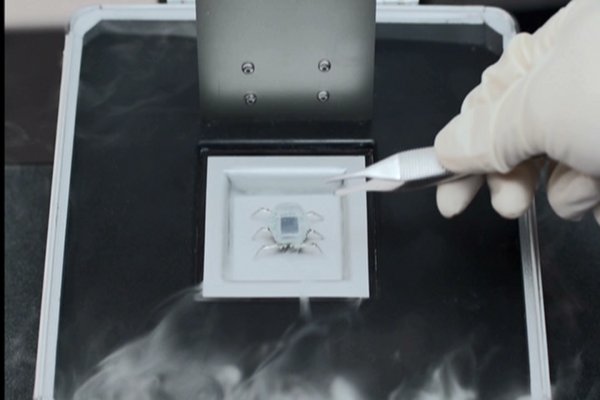
Cyberpunk themes… they got ‘em. There’s little question about this being cyberpunk; It’s practically dripping with cy-punk themes throughout. The Psi-Comp implants can be used to control people, either with persistent commercials or a painful “fail-safe” that can blow your head off, depending on how Hope Co. feels about your finding out about the truth about them. The hackers try to free Luke from Hope’s control over him by using the implant themselves. Hope Co’s. cameras everywhere watching most everything that goes on. There’s even holographic projections of corporate brands above and on cityscapes and landmarks, owing to how corporations had bail out governments due to their failed bailouts. About the only thing missing would be the dystopic atmosphere, though through sound bytes from televisions indicate that the dystopia is financial.
So what could (or did) possibly go wrong? With Hardwired’s abundance of cy-punk themes, it might be hard to imagine that this could not be the next Blade Runner. That might be the big problem: It’s trying to be the next Blade Runner. Not that aspiring to be such a classic is a bad thing, it’s just most cyberpunk movies lately are trying to be Blade Runner, and they try so hard that they ultimately fail to be even a good movie. Let’s try to make a good movie first, then you can try being Blade Runner. Best way to start is to actually do something with those themes. It’s obvious the makers seem to know about what cyberpunk is, but it’s also obvious they don’t know what to do with it all. Maybe they should hang out here for a while…
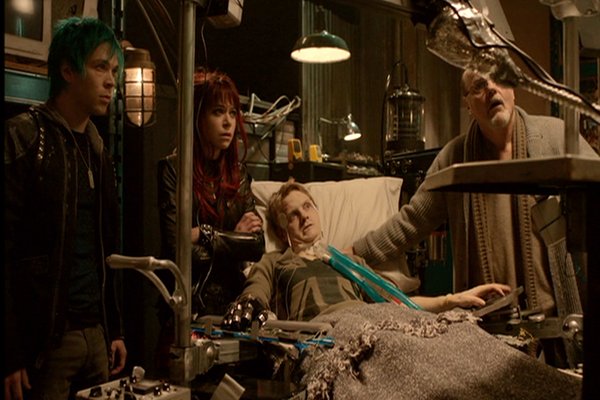
Are you certain that the one on the left is Punk Blue and not Punk Green?
Another problem is more “technical,” the operation scene when Luke gets the implant. Inside the operating room, Luke is sitting upright, but a scene through a security cam (assumed to be in the same O.R.) shows him lying down, face up, even though the doctor just finished drilling into the back of Luke’s neck. It’s not like every movie is one-hundred percent accurate, but such noticeable goofs early on can make the rest of the film less believable. Also, the hackers use the chip to send Luke information a la “augmented reality.” His eyes were not replaced with holographic projectors, so we should not be able to see the transmitted data in front of his face. Seeing that stuff as Luke sees it, first-person like, would have worked better.
Conclusion: It’s hard to put Hardwired down because it has a great idea, but some bad implementations may have doomed it to direct-to-video hell and lack of reviews. The only other review called it “cheesy, seriously cheesy.” Plus, the ending practically begs “please let us become a franchise,” though it might serve better as a pilot for some futuristic TV series. Maybe.
So much potential…
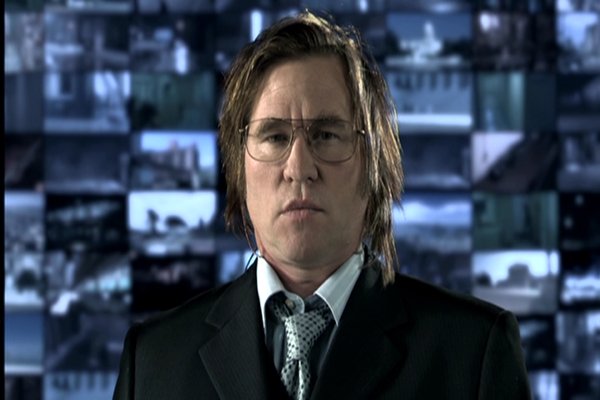
It looks like Bruce Willis now has some competition for the most WTF hairpiece.
Movie Review By: SFAM
Year: 1998
Directed by: Darren Aronofsky
Written by: Darren Aronofsky & Sean Gullette
IMDB Reference
Degree of Cyberpunk Visuals: Medium
Correlation to Cyberpunk Themes: High
Key Cast Members:
- Max Cohen: Sean Gullette
- Sol Robeson: Mark Margolis
- Ben Shenkman: Lenny Meyer
- Pamela Hart: Marcy Dawson
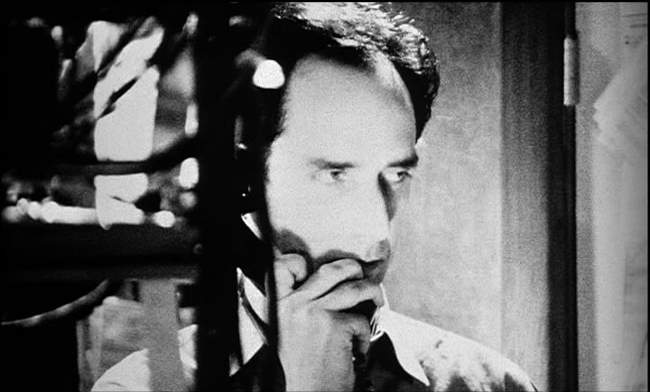
Overview: With a production budget hovering around $60,000, first time film director Darren Aronofsky teamed up with actor Sean Gullette to create a powerful addition to the cyberpunk genre. Filmed entirely in grainy black and white handy cam type shots, Pi is an exploration of obsession. Pi ha an ever-increasing frenetic pacing, terrific acting and interesting ideas. Even though it occurs in current times (as opposed to near future as with most cyberpunk flicks), the cyberpunk nature of this flick is embedded both in its ideas and setting.
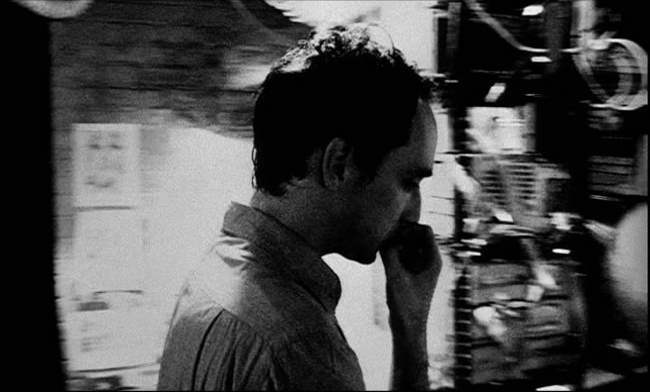
The Story: Max Cohen (played wonderfully by Sean Gullette) is a neurotic, genius mathematician who obsesses about trying to understand the stock market. He begins to think there is an underlying pattern that underlies the dynamics of the stock market – a pattern that can be explained in a 216 digit number. Max developeds an organic supercomputer that takes up the bulk of his apartment to further his search by developing tests and programs, but unfortunately, he still can’t find the answer. As his obsession deepens, he becomes tortured with headaches and nosebleeds.
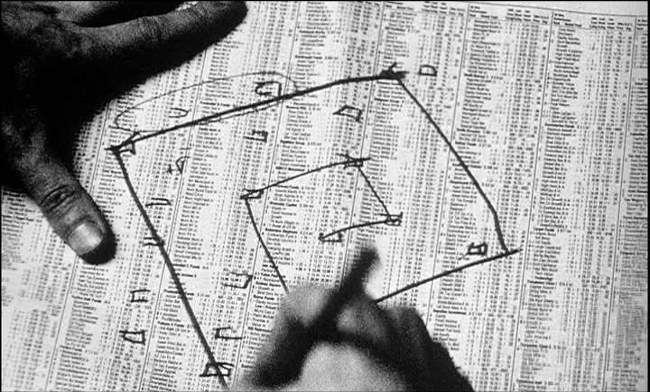
1. Mathematics is the language of nature
2. Everything around us can be represented and understood through numbers
3. If you graph the numbers of any system, patterns emerge. Therefore, there are patterns everywhere in nature. So what about the stock market…
My hypothesis, within the stock market there is a pattern, right in front of me…

Max is paranoid in the extreme, and suspiciously assumes everyone is out to get him. Even his old teacher, Sol (Mark Margolis), comes under suspicion after cautioning Max to moderate his obsession. Max believes he is continually being followed (in fact he is). Finally, a Wall Street corporate representative named Marcy (Pamela Hart) offers him the use of a high-powered, secret chip to run his organic supercomputer – all she wants in return is insight into his results.
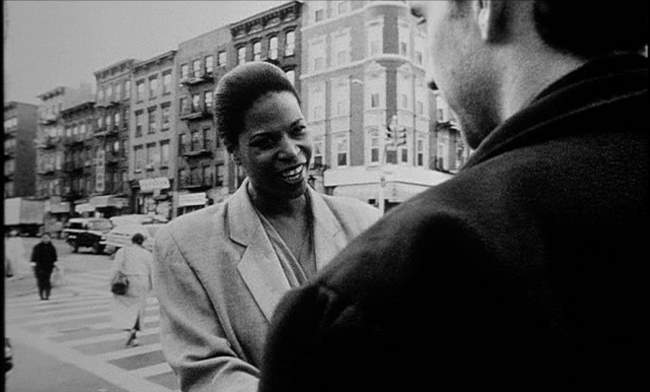
While getting coffee, Max meets a nice Hasidic Jew named Lenny (Ben Shenkman) who appears to have an interest in numerology. As Max gets to know him better, it turns out that Lenny is part of a group seeking God’s real name, which just happens to be a 216 digit number. This group believes that God has made Max his vessel, and in uncovering the secret of the stock market, Max will simultaneously be able to give them the key to salvation. As Max gets closer to finding the answer, it becomes clear that neither of these groups have Max’s best interest in mind - worse, they aren’t going to take “No” for an answer.
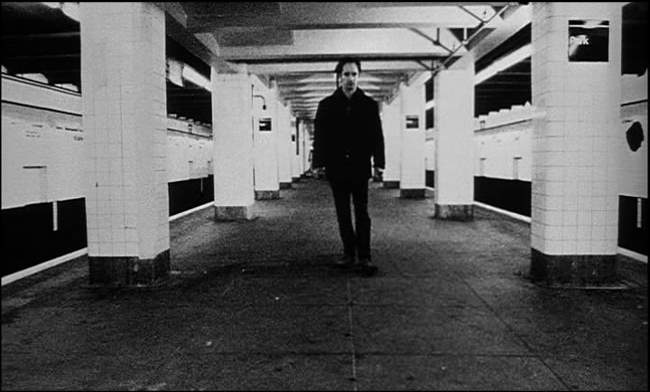
The Cinematography: Given that Aronofsky has so little to work with in terms of budget, its hard to poke too many holes here. The washed out feel serves to make the viewer feel as if they’ve been up as long as Max, with ten too many cups of coffee in their system. The grainy black & white visuals work for the most part, although often one is left with the idea that in experimenting to foster a frenetic feel, Aronofsky sometimes goes overboard. Case in point, the room spinning works wonderfully, but then is taken to annoying extremes. This overly artistic experimentation feel generally works wonderfully, but on occasion distracts more from the story and pacing than it adds.
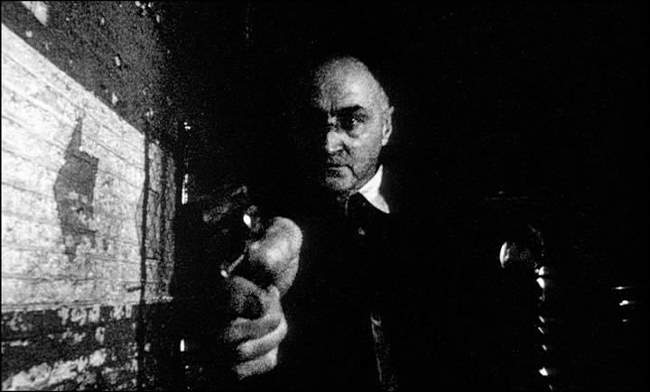
The Sound: As frenetic as the visuals are, these are matched by fast-paced, industrial rhythms and sound FX. The keyboard-laden soundtrack perfectly paces the story, which goes from contemplative moments to fast-paced, paranoid chases and fantasies. Tracks are continually reset to show a resetting of the thought process in the movie, and then spin out of control, again mimicking the transition in the scenes. Pi is one of those movies where the sound is almost as critical to the mood as the visuals itself.
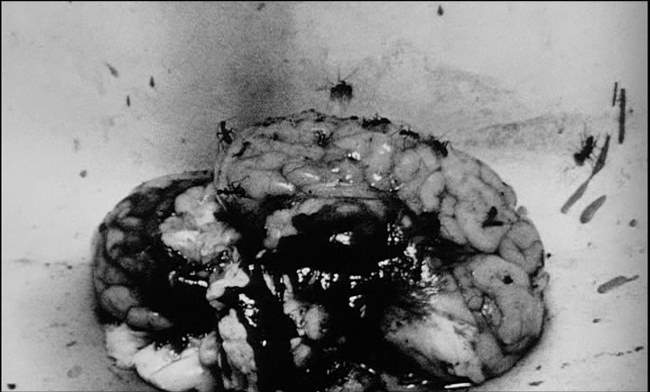
Genius With Insanity: In PI, Aronofsky explores the idea that genius often achieved in combination with insanity. Max Cohen’s mind is unique in that he is a master at number pattern assimilation. His obsession with a 216 digit number, which might be the key to understanding nature itself borders on both genius and insanity. Eventually Max starts to see his brain outside his body, sometimes covered with insects, crawling about. Max begins to imagine puncturing the mathematics portion of his brain to end the obsession. Instead, he continues on his quest. In essence, Max needs to become insane in order to truly tap into his genius.

Converging Knowledge Domains – Economics And Religion: One of the interesting facets of Pi is the degree to which overlapping knowledge domains are explored. In examining whether there is a 216 digit number, of which its meaning and syntax can explain both the stock market and God’s will, Aronofsky juxtaposes the meaning of humanity (God’s will) with society’s insane drive toward wealth creation. Worse, Aronofsky’s setting is a world in which our social context – our human-ness has devolved into a paranoid, lonely landscape, where socialization is no longer about friendship – it’s about survival of the fittest. Max is first and foremost alone. Everyone he interacts with has a nefarious motive. As we move toward a world that is divorced from humanity, one can’t help but wonder what our pattern-finding minds will devise. Aronofsky ‘s answer is clear – finding the stairway to heaven now becomes a by-product of seeking to greedily game the cornerstone of our society’s tally of winners and losers – the stock market.
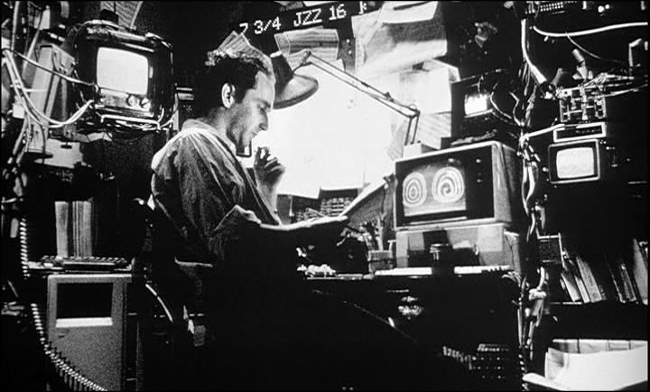
Is Max’s Computer Self-Aware? I totally missed this connection, but Textpundit below makes an excellent case for this:
Okay, I get what you mean when you say “organic”… but I mean actually a small bit “organic”, as in animal. Remember when the computer comes up with the number the first time and then shorts out the processor? When Max goes to change the CPU out, he finds some kind of gooey, organic matter…almost like scrambled brain matter or something similar.
That’s where I came up with the idea that the computer became self-aware (even if only for a split second) when it found the number.
I need to watch this again, but the “gooey” matter that Max keeps finding seems clearly organic in nature. So either this is part of his paranoid delusions (like the external brain), or in fact his computer becomes self-aware. If so, it’s his computer, not Max, who is truly God’s vessel. This actually makes the movie quite a bit more interesting, especially when coupled with the idea that the “vessel” needs to be pure. Clearly no human fits this description, as Max points out to the Rabbi. But Max’s response, “It came to me!” is just as flawed - perhaps it came to his now self-aware computer, who is pure. I’m beginning to think I was just a bit slow in grasping this - did anyone else get this interpretation?
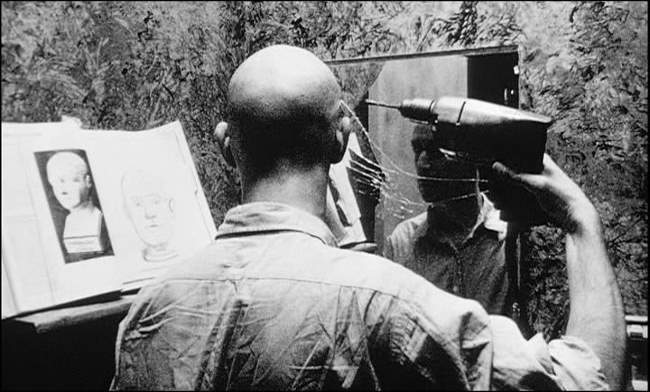
The Bottom Line: The teaming of Aronofsky with Sean Gullette is a terrific one, as they almost seem made for each other. The overall feeling of Pi, while not enjoyable to sit through is certainly very memorable. The ideas are interesting, but it’s the wonderful acting, immersive mood and frenetic pacing which really sell the film. I must admit though, the first time I saw Pi (years ago, before I created this site) I wasn’t as enamored with it as I am now. It really took a second viewing for me to warm up to – it grows on you.
Movie Review By: Mr. Roboto
Year: 1992
Directed by: Phil Alden Robinson
Written by: Phil Alden Robinson, Lawrence Lasker, Walter F. Parkes
IMDB Reference
Degree of Cyberpunk Visuals: Low
Correlation to Cyberpunk Themes: Medium
Key Cast Members:
- Martin Bishop (”Marty”): Robert Redford
- Donald Crease: Sidney Poitier
- Erwin Emory (”Whistler”): David Strathairn
- “Mother”: Dan Akroyd
- Carl Arbegast: River Phoenix
- Liz: Mary McDonnell
- Cosmo: Ben Kingsley
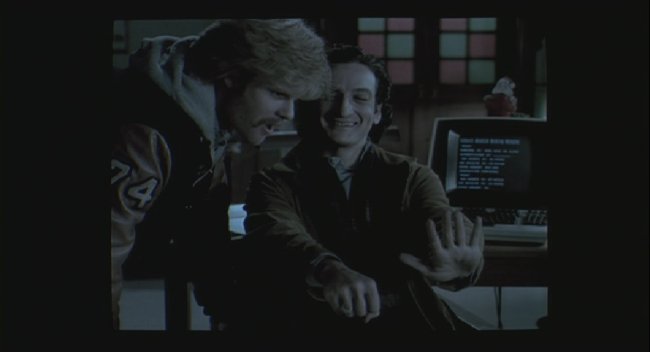
December 1969: Marty and Cosmo just helped the Republicans make a donation to the Black Panthers. Right on!
OVERVIEW: Martin Bryce is a fugitive since December 1969 when he left for pizza while his friend, Cosmo, was arrested for their hacking activities. Now living as Martin Bishop, he leads a “tiger team” that tests security systems. Two men claiming to be from the NSA want to hire Marty’s team to retrieve a “black box” developed by a brilliant mathematician for a project called “SETEC Astronomy.” They succeed in retrieving the box, but when they discover what it is, that’s when the real danger begins…
Note: Not an actual screen shot. Animation of key Scrabble moment in movie.

Remember: When playing Scrabble on Monterey’s Coast, keep score on My Socrates Note or you’ll end up with Cootys Rat Semen!
Sneakers is an intellectual cyber-caper movie that features an all-star cast with a slick production. There’s little question about this being a great movie to watch…
… But is it cyberpunk?: Some might question whether Sneakers qualifies as a cyberpunk movie. Other cyberpunk sites do list it as such, but does it make the grade here? Let’s compare it to SFAM’s idea of what makes a movie cyberpunk:
- Negative impact of technology on humanity: The “black box” is capable of breaking the most secure encryption codes without the need for a key. Whoever has this device can essentially read any e-mail, site, or whatever they want, without needing a decryption key. Sound pretty negative to me.
- Fusion of man and machine: In literal terms, no such fusion occurs here. The closest would be Whistler using his braille terminal, though one might say that Marty’s team does work like a well-tuned machine.
- Corporate control over society: Things are a bit hazy here. While there’s no such control apparent, one can imagine what the wrong people can do with the “black box.”
- Story focuses on the underground: Mary and Cosmo are hackers from the 60s. Cosmo works with organized crime (”Don’t kid yourself. It’s not that organized.”), and Marty’s team is mostly made from people who got into trouble with some type of technical activity.
- Ubiquitous access to information: The ability to decrypt and read any site or message. ‘Nuff said.
- Visuals and style: Being set in modern San Francisco (circa 1992) makes it impossible to depict a near future, but there are scenes where single colors and contrasting schemes are apparent: The red brick of the team’s office during the Scrabble scene, the darkness of Marty’s ride in the trunk of a car, Cosmo’s bluish office with the bright white “soundproof” room.
The movie itself has an intelligent style that often make viewers think about the consequences of the “black box” decrypter, politics, privacy, and the role of the NSA.
The Bottom Line: This is definitely one that needs to be in your collection alongside WarGames. It’s a fun, intelligent, and even humorous (sometimes darkly humorous) adventure into our privacy at stake. As to whether it can be called cyberpunk…
WHO CARES?
You’ll definitely like watching Sneakers and trying to decide for yourself
And while you watch this gem, keep this almost Matrix-like observation in mind:
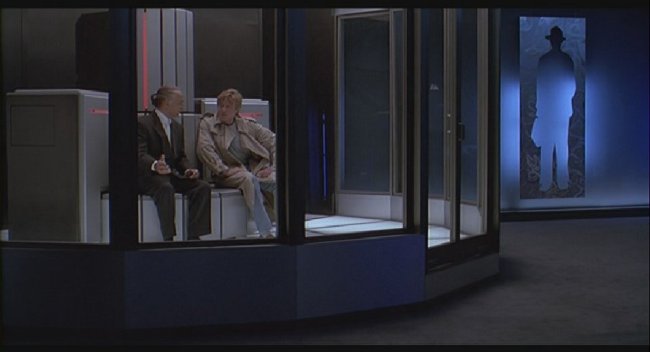
“… I learned that everything in this world, including money, operates not on reality. — But the perception of reality.”
Page 2: More Screencaps –>>
Movie Review By: SFAM
Year: 2002
Directed by: Kenji Kamiyama
Written by: Masamune Shirow (Story), Kenji Kamiyama (Chief Writer), et al.
IMDB Reference
Degree of Cyberpunk Visuals: High
Correlation to Cyberpunk Themes: Very High
Key Cast Members:
- Major Motoko Kusanagi: Atsuko Tanaka (Japanese), Mary McGlynn (English)
- Batou: Akio Otsuka (Japanese), Richard Epcar (English)
- Chief Daisuke Aramaki: Osamu Saka (Japanese), William Knight (English)
- Ishikawa: Yutaka Nakano (Japanese), Michael McCarty (English)
Rating: 9 out of 10
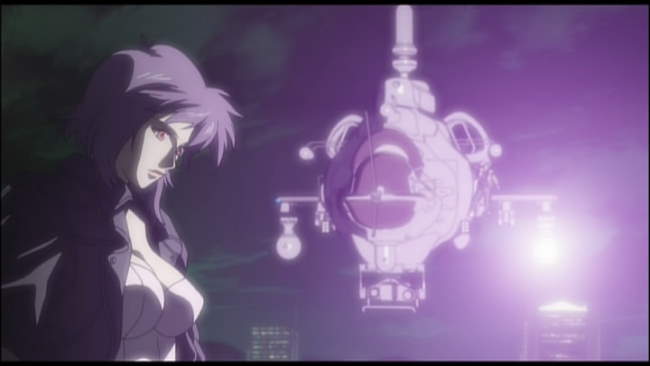
Overview: Ghost in the Shell Stand Alone Complex (GITS SAC) uses the same characters as Masume Shirow and Mamoru Oshii, but takes place prior to the first GITS movie. Like the GITS movies, GITS SAC revolves around Section 9, an elite anti-terror police force that works behind the scenes to keep the peace. The overall tenor of this series is far more action oriented than Oshii’s movies. While there are a few philosophy moments (including a terrific one with Batou and the Tachikomas), the vast majority of the season is action oriented. In short, we get high-end, slick cyberpunk butt-kicking in GITS SAC – one that’s well worth watching, even if you do miss the philosophy.
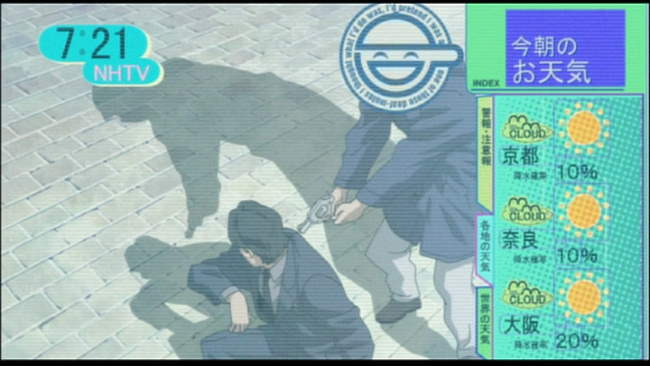
The Laughing Man Story: In a world where cyberization has become the norm for a large segment of the population, a number of negative side effects have become possible. In addition to cyberbrain hacking, a disease called Cyberbrain Sclerosis has emerged which seems to randomly affect many who’ve undergone significant cyberization. The Mega-corporation, Serano Genomics has produced a cure for Cyberbrain Sclerosis – Serano Micromachines, a nanotech implant device that, when ingested regularly supposedly halts and eventually works to cure the disease. Unfortunately, the Micromachines only seem to help a small segment of those contracting the disease. A hacker named the Laughing Man seems bent on exposing a cover-up – one which posits that the lost Murai Vaccine has an almost permanent curative for those with Cyberbrain Sclerosis. Unfortunately for Serano Genomics, a real cure for Cyberbrain Sclerosis would decimate their profitability.
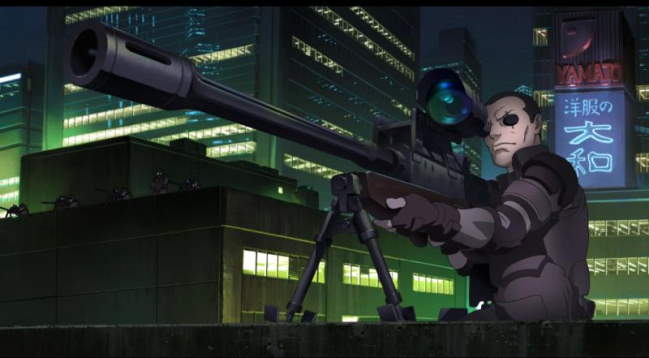
The Laughing Man is a hacker extraordinaire who is able to hack into cyberbrains at will, and worse for public confidence, is able to take over TV shows at will. Section 9 has been brought in to find and stop the terrorist known as the Laughing Man. Throughout the season, while there are side plots, it’s the Laughing Man story which drives Section 9. As it continues, the intrigue builds and the plot thickens. Eventually, corporate betrayal, political scandals and personal vendettas play a role in setting the context and exposing the larger truth.
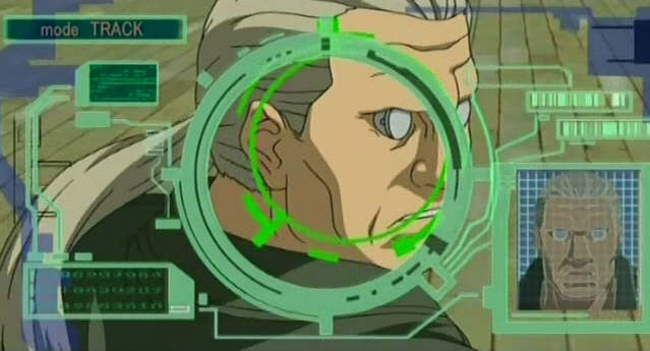
The Side Stories: While the Laughing Man is the focus of the season, there are many side quests in GITS SAC. Some of the episodes closely resemble stories from Masume Shirow’s original GITS Graphic Novel. Among these, Batou has an interesting commando encounter with his past, and Aramaki is taken prisoner by thieves in a bank, only to get involved in a more intriguing plot. For him to survive, Motoko must be able to interpret his actions from afar to correctly figure out his strategy. Generally, the stand-alone episodes are good enough to keep you entertained – some are excellent.
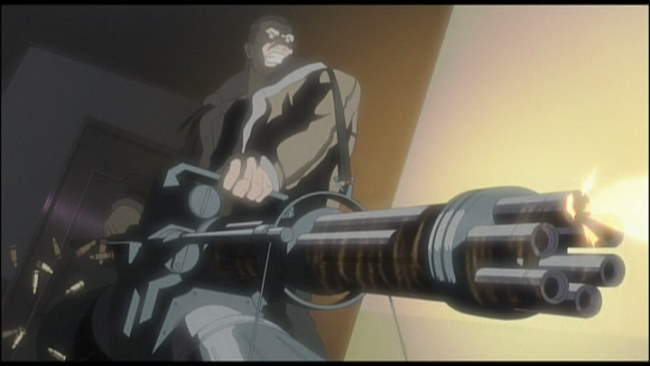
7Th Volume is the Best: While GITS SAC is pretty good throughout the series, the 7th volume – the last one – is by far the best. Without the 7th volume, I would probably rate GITS SAC 8 stars, but the 7th volume really deserves a 10 star rating. In the 7th volume, Section 9 is disbanded, while political intrigue hounds their very lives. The team escapes a crack commando unit and then all go their separate ways. Motoko and Batou become the focus of the volume, and in doing so, display more humanity and feeling then they do the rest of the series. On top of this, many of the best FX are found in volume 7.
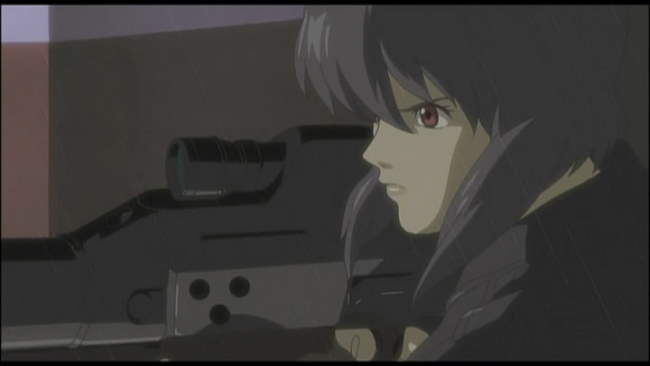
Differences with Oshii and Similarities with Shirow: Whereas Mamoru Oshii’s movies centered on the impacts of a cyberpunked society to the individual (Motoko in GITS, and Batou in GITS: Innocence), GITS SAC tends to broaden the filter to look at overall patterns in society. This leads to wonderful throw-away gems like the virtual meeting room (basically a holodeck) where everyone jacks into the meeting and then disappears when complete. We also get plots centering on problems with children in this changed new society, alienation of the masses, and loss of identity and humanity as technology takes center stage in human interaction. GITS SAC is also far more like Masume Shirow’s original graphic novel. While it doesn’t have the overt sexuality of Shirow’s work, Motoko is drawn as Shirow would; Shirow’s humor is evident in a number of the episodes; and the action takes center stage for the most part.
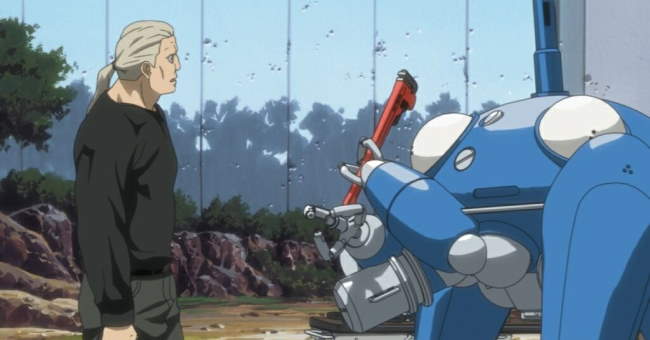
The Tachikomas: Early on, Major Motoko Kusanagi determined that the Tachikomas weren’t destined to be front-line fighting droids. For this reason, in order to become useful, the Tachikomas sped up their learning AI processing. As the season progresses, the Tachikomas begin to exhibit full signs of sentience, including Freewill and more devious functioning – so much so that Motoko becomes worried about their potential. Many interesting discussions take place over the development of the Tachikomas. One of the more intriguing ones that wasn’t really answered was whether being a digital life form instead of an analog one, would the Tachikomas ever develop a Ghost?
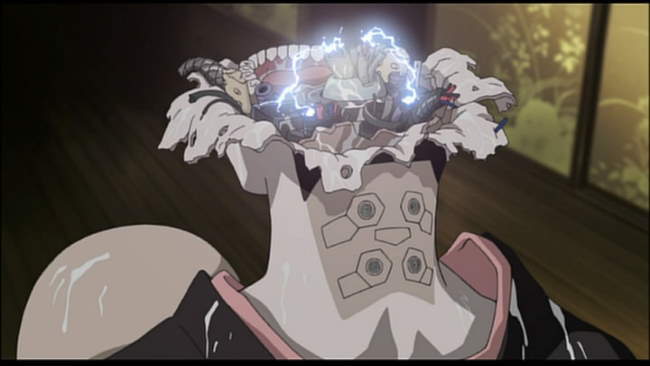
External Memory Devices and Cyberbrains – Augmented Thinking: One of the really interesting things about the GITS world is the integration of augmented brains. Conversations and complex thinking become dramatically enhanced. While the philosophical conversations are significantly reduced in GITS SAC when compared to the GITS movies, we still get a myriad of instances where cyberbrains allow people to call up a set of details about any subject that no other human could ever do. Cyberbrains in GITS SAC show a society where humanity truly has become post-human in a very real way, even though the actual look of most humans hasn’t changed much.

The Dubbing: GITS SAC is one of the few animes where the English cast is just about as good as the Japanese cast. Both William Knight (Aramaki) and Richard Epcar have been in their roles from the initial Ghost in the Shell movie in 1995, and all of the cast members have stayed consisted for both GITS Innocence and GITS SAC. Atsuko Tanaka (Motoko), Akio Ôtsuka (Batou), and Kôichi Yamadera (Togusa) have also been in their roles since 1995. It’s hard to pass up on Atsuko Tanaka though – I love her as Motoko. In any event, while the moods between the English and Japanese cast are different, they are both excellent.
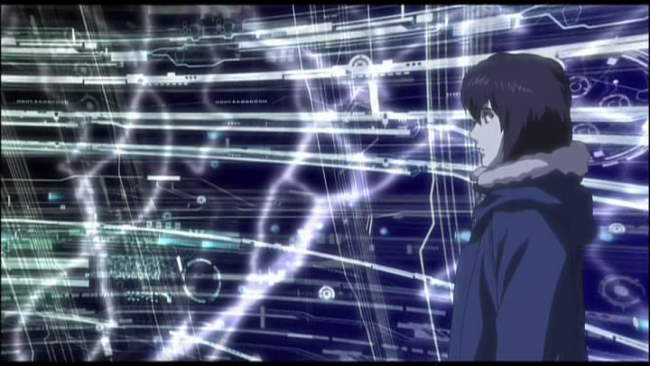
The Sound: GITS SAC consistently has decent quality sound supporting the visuals. The use of the side speakers for voices is especially emphasized. The sound FX (explosions, gun shots, car chases) are always top notch. But truly, the most impressive thing in terms of sound is the sound track. The opening and closing songs (Inner Universe and Lithium Flower) by Yoko Kanno are flat out terrific. Throughout, we are treated to a variety of songs and background music, which almost always add to the action and visuals on screen.
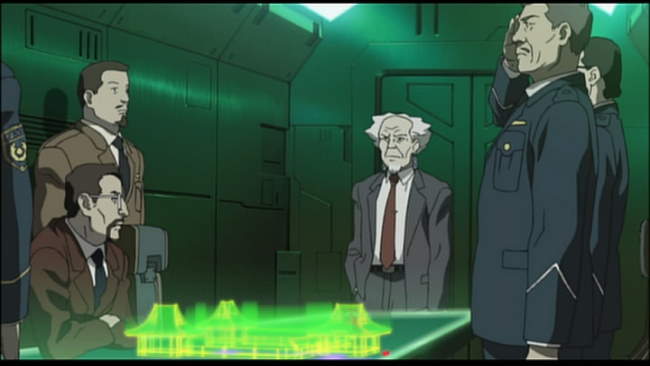
The Visuals: GITS SAC has a variety of aids that add to the overall quality of the look. While some shots look pretty basic, others involve a variety of cool FX, including digital color grading, a myriad of environmental effects, and cell-shaded computer models. GITS SAC gives us a variety of color palettes including dominant greens, reds and blacks, and occasional blues and yellows. Overall, GITS SAC is a very professional, high quality production.

The Bottom Line: GITS SAC is a high quality cyberpunk production. While I personally like the tone and tenor of Oshii’s movies far more than I do GITS SAC, this is a personal preference. GITS SAC provides continued quality action wrapped up in impressive visuals and sound. While the first 6 volumes might only merit an 8 star rating, the conclusion is just terrific. This, along with the overall high level crafting GITS SAC provides throughout (visuals, sound, dubbing, songs) certainly raises the bar. And do yourself a favor – watch GITS SAC on a system with high quality surround sound – you’ll notice the difference.
Movie Review By: SFAM
Year: 1999
Directed by: Scooter McCrae
Written by: Scooter McCrae
IMDB Reference
Degree of Cyberpunk Visuals: Low
Correlation to Cyberpunk Themes: Medium
Key Cast Members:
Ginny Chin-Chin: Jane Chase
Adrian Torque: Crawford James
Alik Silens: Alice Liu

Overview: WTF!!! That pretty much sums up Sixteen Tongues. This low-budget softcore cyberpunk porn flick has potential in some of its thoughts, but just loses out in editing, movie making basics like clear dialogue and pointless filler scenes. Low budget flicks often free the director to stop paying attention to movie conventions and potentially create something unique. But to make this pay off, some of the basics of crafting still need to be worked.
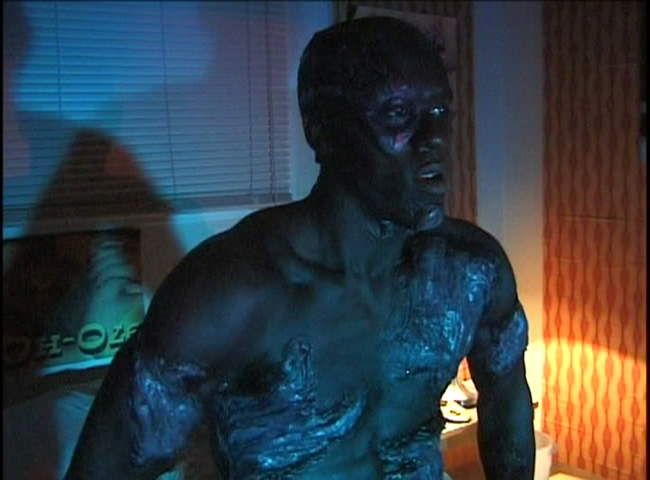
The Story: In a dystopic, seedy future, where humanity is fleeting, Sitxteen Tongues follows the plight of three emotionally scarred people (one physically scarred as well). Adrian (Crawford James) is a severely scarred police officer who seemingly died in a previous conflict, but was brought back to life, and had his damaged skin repaired by replacing it with sixteen tongues. His tongue skin, which forces him to taste his own clothes and everything he touches, has since made him go crazy – he hears voices and every now and then, and randomly goes on murderous rampages. Ginny Chin-Chin is a bio-modified assassin droid who has had sexual implants causing her to organism every time she blinks her eyes. The implants help her resist the urges to kill, but she still is driven to find her maker and rip him into shreds. Alik is a hacker extraordinaire, and is Ginny’s lover. She spends her time trying to find Ginny’s maker, but also has the ability to user her equipment to ghost-hack into other’s minds.
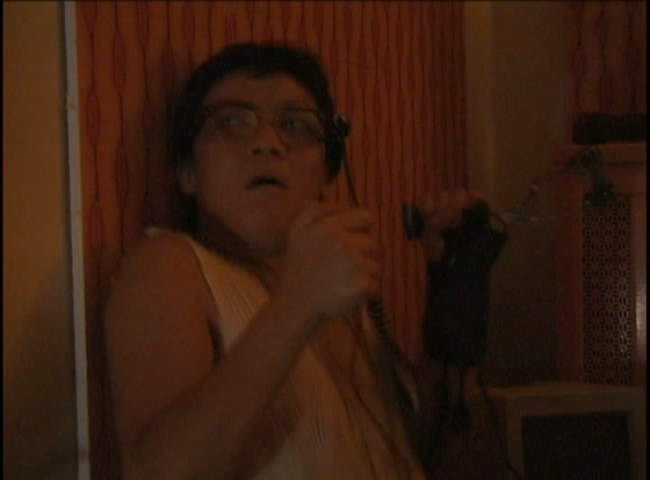
All three characters are emotionally traumatized. Alik and Ginny spend half the movie fighting about whether they really care for one another. Adrian is caught up in his own paranoid delusions. Through a chance encounter to get ice, Ginny and Adrian meet up. Ginny goes to his room (which has porno films playing non-stop) and finds out he’s a cop. She thinks he can help her in finding her maker, so she gives him oral favors in exchange for potentially helping her. While Ginny is having sex with Adrian, Alik hacks into Adrian’s TV signal and watches them. More arguments ensue.
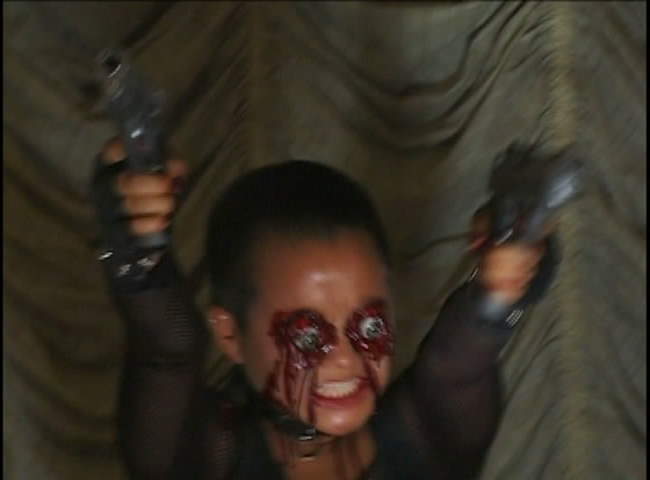
Eventually things come to a head due to Adrian’s paranoid delusions. In scanning Ginny’s bar-code, he knows she is a dangerous murderer, and for some reason, begins to think Ginny is actually responsible for his murderous rampages. Confrontations occur, and things spiral out of control from there.
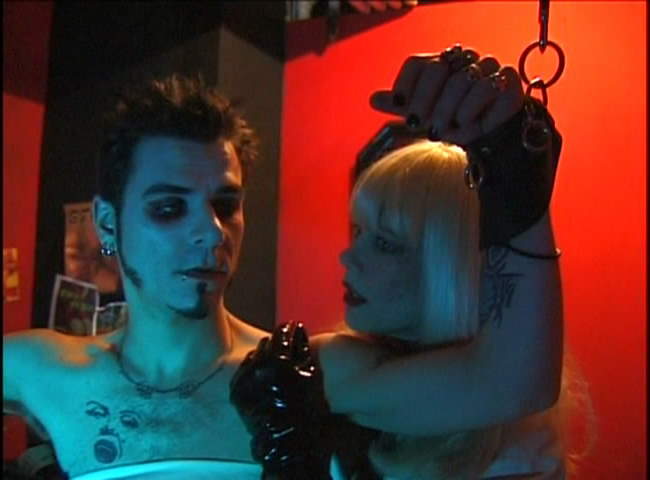
The Set: The entire movie takes place in a few rooms in a seedy hotel with porn posters covering all the walls. The hotels don’t look at all futuristic, aside for the credit card swap machines everywhere. They do at least look very seedy and lived in, although the random people sleeping on the floor was probably overkill. Also, we eventually learn that complete sexual deviants fill virtually every hotel room.

Picture slightly airbrushed out in obvious places. Go here for original.
The Nudity: Fair warning – Ginny Chin-Chin spends well over half the movie either in the buff, in a sheer shower-stall plastic outfit, or in her fishnet get-up. She definitely looks hawt in this, whereas Alik, also nude some of the time, is made to look as nerdy as possible. In addition, we are treated to other random nude chicks we see as the movie progresses. Blood and gore are also in high supply here.
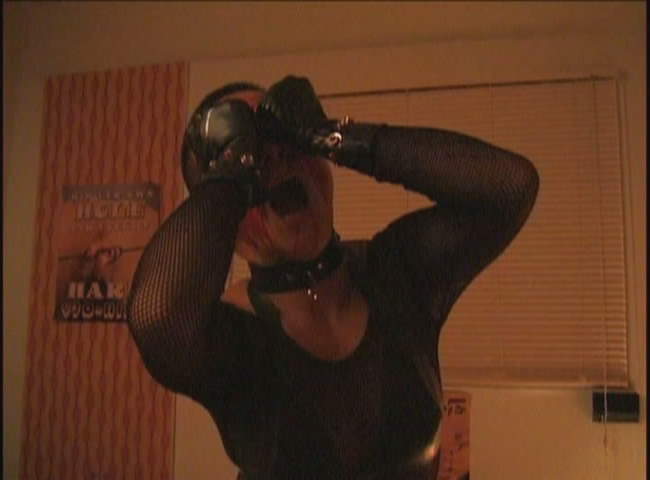
The Props: While at first glance, this movie borders on hard core by having an oral sex scene, if you look closely (or watch the extras), you can see that this is a prop. The dildo prop has various warts on it and spurts blood. Adrian’s facial skin grafts look pretty cool, and generally look like a part of him. Alik’s hacker tools, while extremely low-tech, at least pass some minor degree of believability.
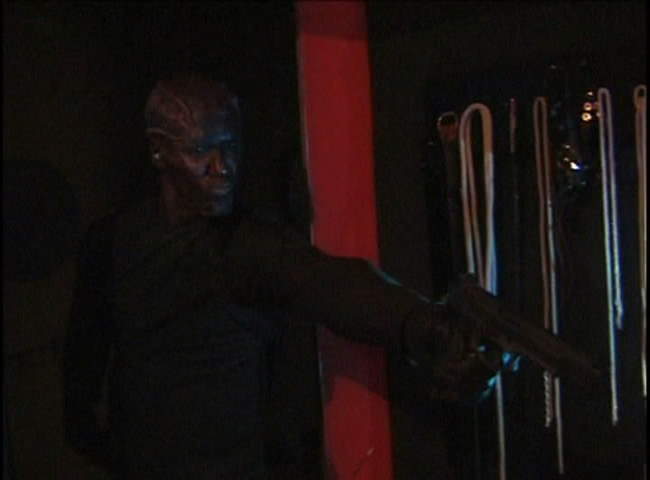
The Sound and Lighting: If there’s a place that Sixteen Tongues falls flat on it’s face, it’s the sound. The actors are clearly not that experienced, and tend to mumble their lines. Worse, McCrae, the director, doesn’t seem to mind. With this combination of poor quality sound reproduction and mumbled lines, the viewer is left to decipher the dialogue in many of the scenes by watching reactions. Adrian and Alik are the worst at this. There are a few scenes of each where the view has no possibility of figuring out what is said. The lighting is also atrocious. Constantly we get over-exposed actors or actors completely blotted out by a bright light behind them.
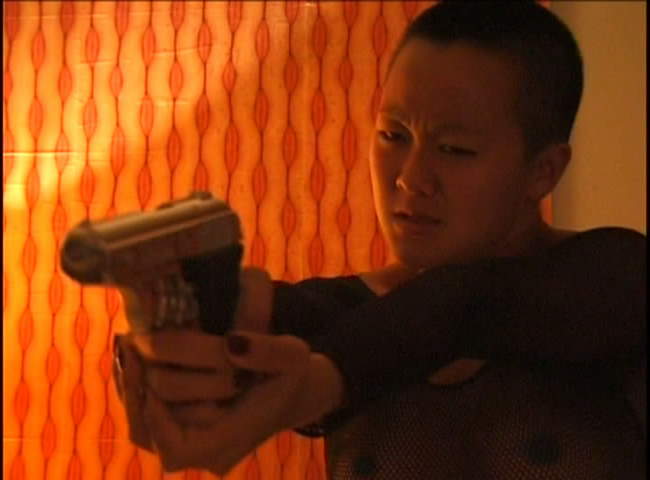
Picture slightly airbrushed out in obvious places. Go here for original
The Bottom Line: Some of the ideas with Sixteen Tongues are pretty interesting. The hacker approach is very similar in some ways to Neuromancer in that it really doesn’t seem to recognize a modern internet, but instead goes towards this almost inaccessible cyberspace that only specialized hackers can use. Unfortunately, some ideas, including the Android assassin bit, and the briefly mentioned bacteria-taking over the body and mind bit are barely even explain. While the plot is problematic and the acting sub-par, it’s the basics – lighting, editing and sound that really doom Sixteen Tongues. Again though, Jane Chase as Ginny Chin-Chin does look pretty smokin in her various get-ups. So if you want to see a bizarre, edgy, low-budget approach to cyberpunk with lots of nudity and gross scenes sprinkled throughout, you might get some enjoyment out of this.
~See movies similar to this one~
Movie Review By: SFAM
Year: 2002
Directed by: Terry Cunningham
Written by: Flavia Carrozzi, Terry Cunningham & Steve Latshaw
IMDB Reference
Degree of Cyberpunk Visuals: Low
Correlation to Cyberpunk Themes: Medium
Key Cast Members:
Nick ‘Jester’ Chase: Nick Cornish
Neville: Adrian Paul
Skylar: Bai Ling
Tess Woodward: Vanessa Marcil
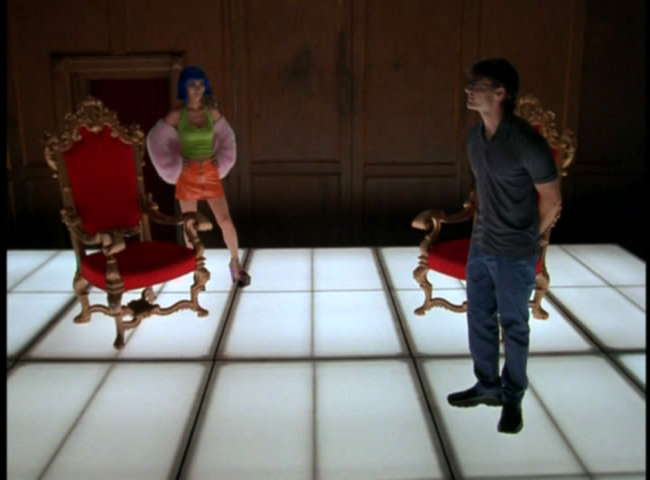
Overview: Overview: Codehunter (a.k.a. Storm Watch) is a fun, but absurd low budget AI and VR flick. This is not a movie who’s technical plot holds together, but it does work as a bubble-gum current-setting hacker-cyberpunk romp. Code Hunter is another War Games-Hacker-Colossus, the Forbin Project rip-off, but in a simplistic and enjoyable way. I’m a sucker for movies with either Bai Ling and Adrian Paul in it. Along with those two, the supporting cast which includes Babylon Five’s Jerry Doyle, Vanessa Marcil and Nora Dunn is pretty fun too.
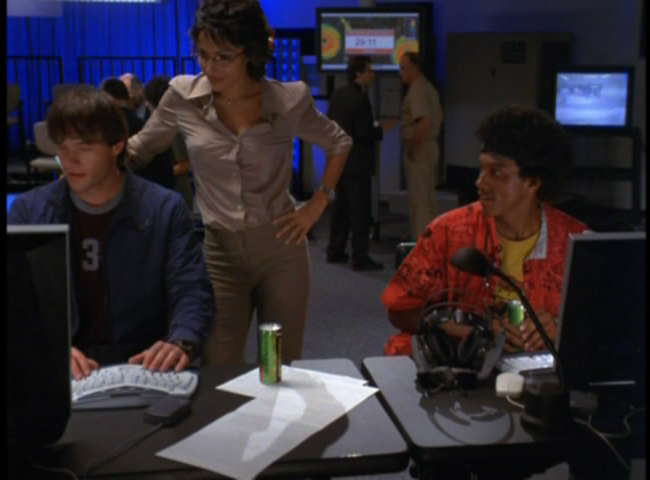
The Story: Nick “Jester” Chase (played by Nick Cornish) is a reformed hacker who likes to hang out in a VR first person shooter game called Shock. Simultaneously, a small computer firm is attempting to sell the US Navy on a new satellite system called “Thunderhead,” which is designed to control the weather. Nick is contacted in the game by Skylar (Bai Ling), a computer genius extraordinaire, to steal a file from an unknown computer system. After refusing, Skylar blackmails Nick by modifying his record to make him a wanted fugitive. Skylar agrees to steal the file, but then hides it and tries to go to the news station to seek protection. He enlists the aid of up and coming reporter, Tess Woodward (Vanessa Marcil), who agrees to help him.
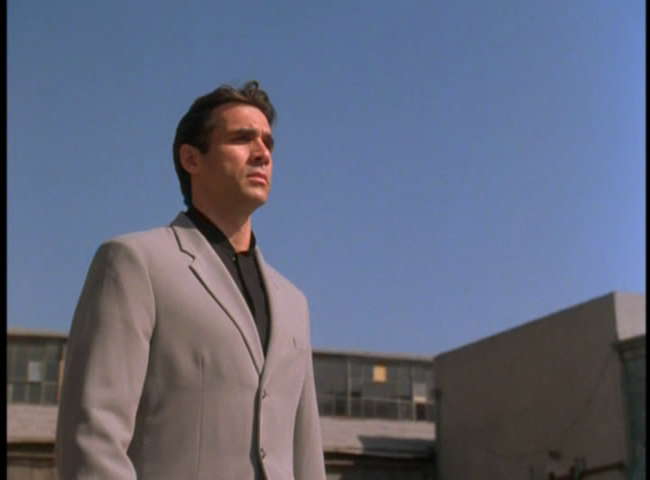
Unfortunately, Thunderhead appears to be out of control, and has created two massive hurricanes on each side of the US that will devastate the both coasts, causing potentially millions of deaths and billions in damages. The government tracks down Nick and bring him in for questioning. As the plot unfolds, it appears that a strange connection between the VR game “Shock” and Thunderhead emerges. Unless they can unravel it, the consequences will be catastrophic.
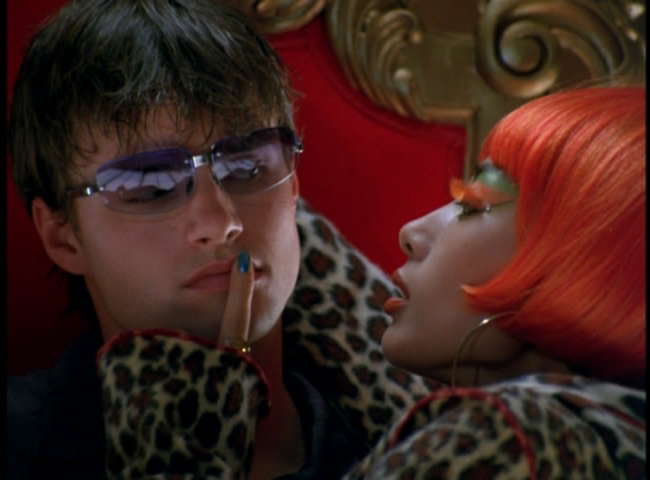
The Bottom Line: Although the cast is fun, and the pacing is good, the actual plot points and coherency are well past the point of believability. They are too numerous to count, but suffice to say the good guys had a number of obvious solutions that could have stopped the catastrophe. To add insult to injury, the movie overstretches its AI angle – had it stopped earlier, it would have worked within the narrative, but instead, they go for the sappy “teach me all of humanity” angle. Again, the movie is fun to watch, but lacks any real intelligence.
~See movies similar to this one~
Movie Review By: Metatron
Year: 1998
Directed by: Rob Bowman
Written by: William Gibson & Tom Maddox
IMDB Reference
Degree of Cyberpunk Visuals: Medium
Correlation to Cyberpunk Themes: Very High
Key Cast Members:
Esther Nairn/Invisigoth: Kristin Lehman
Fox Mulder: David Duchovny
Dana Scully: Gillian Anderson
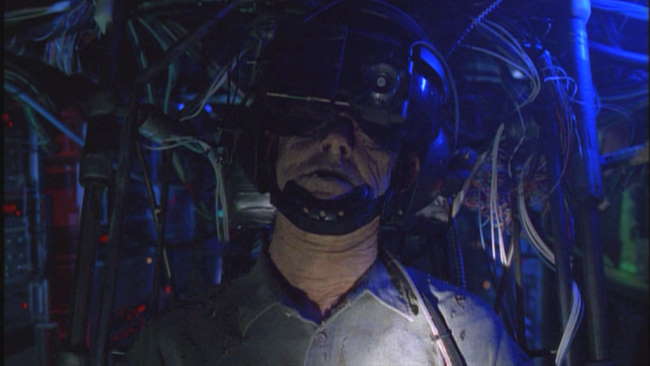
This is what happens when you forget there IS a real world outside…
Overview: Now, surely there must have been some kind of mistake. This is Cyberpunk Review, right? OK. Since when stories of little green men do qualify as such? Surely the mere fact that agent Scully had an implant in her neck does not count for an awful lot.
All true. This particular episode, however, is different. Look at the credits. William Gibson. Ring any bells?
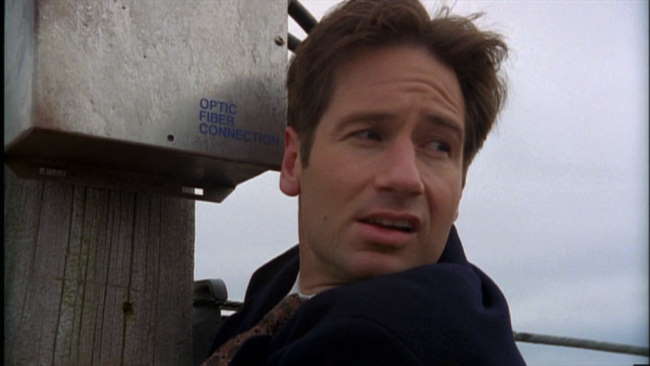
More Than Meets the Eye: It all starts with a rather innocuous shootout at a diner in a drab neighbourhood. Piece of cake, eh? Well, not exactly, as it turns out that one of the victims is in fact a top IT expert and programmer whose death might have been anything less than a coincidence. Soon afterwards Mulder and Scully happen upon a rather charming lady going by the nick-name of Invisigoth, who turns out to be much more than just a leather-clad Trinity wannabe…
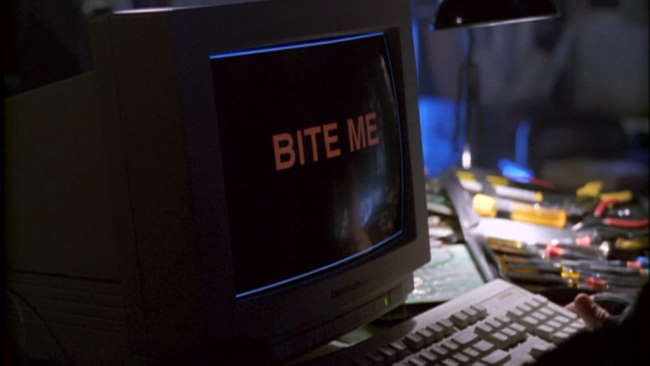
The threat, it is revealed, comes from a fugitive AI she and her companions helped to spawn. This synthetic entity seems to have little regard for human life, plus it possesses some rather eccentric habits, such as playing with leftover Star Wars military orbital lasers and residing in abandoned… camping trailers. Needless to say it has to be stopped, although it may yet turn out Invisigoth pursues a different agenda altogether…
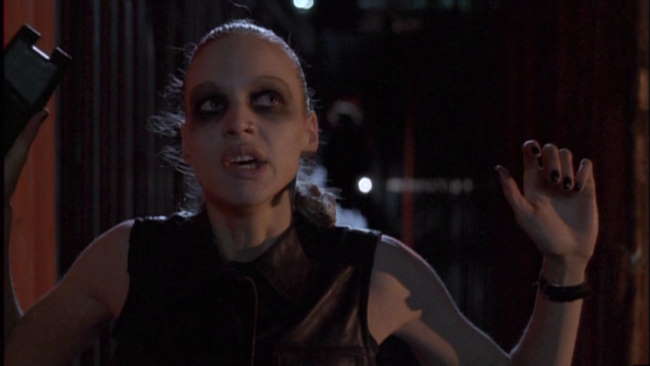
“Okay mom, I did actually use your eye-liner…”
Out There: Even if the credits said “Jay Leno” or “Kermit the Frog” rather than Gibson, there still would be a good case to make for the overall cyberpunk feel of this standalone episode. In terms of themes, it is all there- the pursuit of the AI takes place both in our very own “desert of the real” and through the net; agent Mulder even gets to become a multiple amputee courtesy of the malicious program’s VR simulation. More interestingly, the episode deals with the transfer of consciousness- translating a human psyche into digital data in pursuit of a peculiar kind of disembodied immortality. It is at that point one may begin to realise that one of the foremost attractions of the concept of sentient cyberspace entities is that cyberspace begins, to the mind of many, resemble a manufactured heaven of sort, a synthetic paradise for the unbelievers, allowing those of little religious zeal to dream of achieving transcendence. This move to another plane of existence, an ersatz afterlife- may not be explored at lengths here, yet gives a good cause for reflection. Apart from the sentient computer theme there is of course our sweet little Trinity impersonator (prettier than the real deal? I might be getting controversial here…) who also happens to drive a car (1960s Imperial, to be exact) very similar to the black Lincoln in the first Matrix.
Convinced? And then you realise that this episode actually comes from 1998, which is a year BEFORE tha Matrix… So, who’s the copycat, eh Trinity? Guess I should be expecting a lawsuit for these allegations any time now…
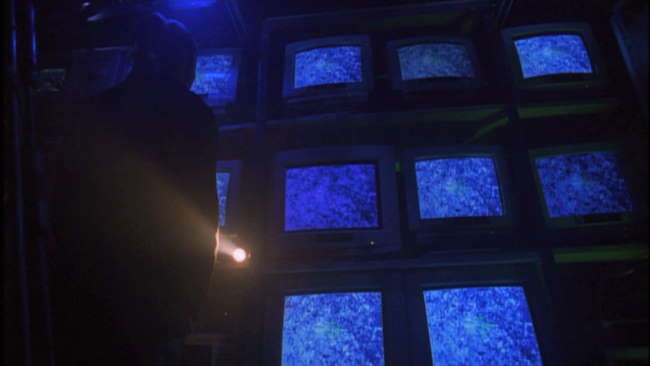
The Visuals: While not trying to rival Blade Runner, the visuals are decent for the budget. Being that this is an X-files episode, we shouldn’t expect anything too fancy - the series rarely relies on fancy visuals to generate their mood, or to depict story elements. One of the distinct traits of the X-Files is that they can often make ordinary places or events appear menacing and sinister when placed in the given context - this applies to Kill Switch.
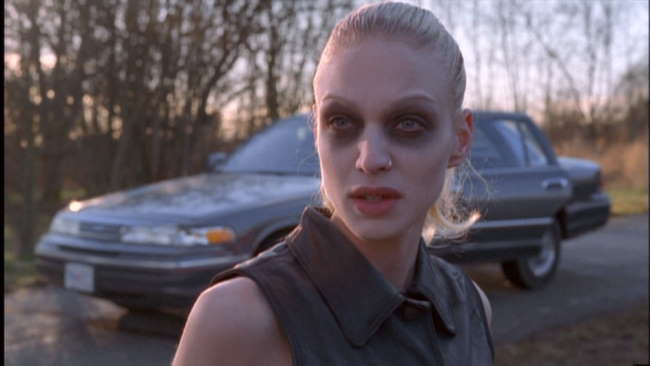
I assure you that, having seen this episode, the next time you’ll see a decaying camping trailer you’re gonna think twice before approaching it. In a way this depiction of cyberpunk is more realistic - inconspicuous locations concealing the drama of furtive technological experiments and computer crime is very much what one’s bound to encounter today. The most important bit - the flow of data - is hidden from the eye. The episode does treat us to some juicy cyberpunk visual elements, including gloomy improvised computer labs, and chaotic nests of cables and wires lit by the dim glow of terminal screens - but nothing too extravagant (aside for a few explosions).
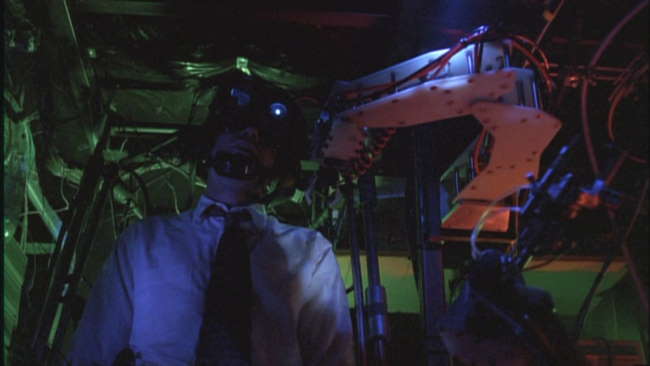
Confirm File Delete: Overall the episode represents a truly interesting foray of the famous franchise into the realms of cyberpunk, courtesy of Mr. Gibson himself. As with many other episodes, the strength of Kill Switch lies in its inherently believable narration, a mixture of the ordinary and the imaginary that made the series famous. The acting is decent- Invisigoth oozes character- and the action tightly coiled into a mere 45 minutes of film. Yet because of the unspectacular nature of the whole thing few will probably have seen and noticed it, even if this is as close as we can get into having a Gibson story made into a feature film, after his Alien3 script got binned long ago. It may not be cyberpunk canon in any way, but do watch it- I swear that after those 45 minutes you’re likely to be craving for more. Which you just might get, as there is another Gibson-written X-File which I will investigate soon…
~See movies similar to this one~
Tags: TV episode review
Year: 1995
Directed by: Iain Softley
Written by: Rafael Moreu
Degree of Cyberpunk Visuals: Medium
Correlation to Cyberpunk Themes: Medium
Key Cast Members:
Dade Murphy/’Crash Override’/'Zero Cool’: Jonny Lee Miller
Kate: Angelina Jolie
: Fisher Stevens
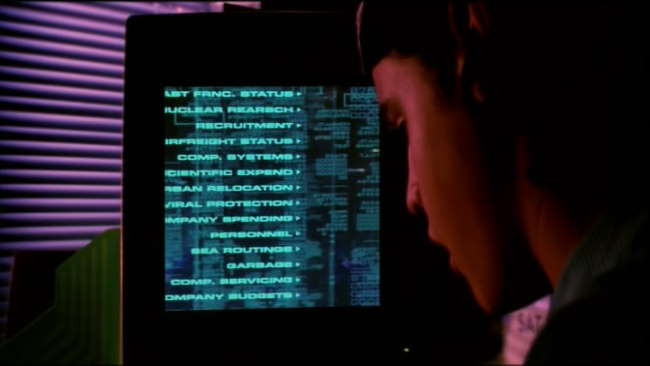
“You are elite.”
Overview: OK, so its not near future, but these kids have the glorified underground hacker thing down. In Hackers, every computer is networked and available for hacking. Hackers gives us a plethora of cool computer imagery cut scenes, 3D buildings serving as file share stores, and lots of underground punk visuals. These visuals are packed into a nicely paced movie that makes the outlandish story of high stakes theft, environmental destruction and hacker antiheroes fun to watch.
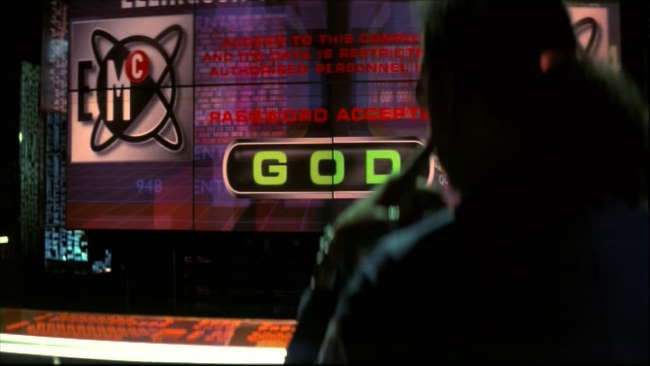
Using “God” as the password is not very secure, but it does serve to highlight the hacker feeling of omnipotence.
The Story: Hackers follows the life of a group of “Elite” hackers, who, through chance while playing a hacking game, uncover a plot within a large bank to contaminate the environment by blaming innocent hackers on messing up software that causes automated oil tankers to spill in order to cover up the theft of millions. The lead bad guy, code name “The Plague” (played by Fisher Stevens) is also a hacker, except that he has “sold his soul” to corporate life and serves as the lead security consultant. The struggle between the hackers and The Plague inevitably brings in the hapless police, who immediately are duped into arresting the hacker force.
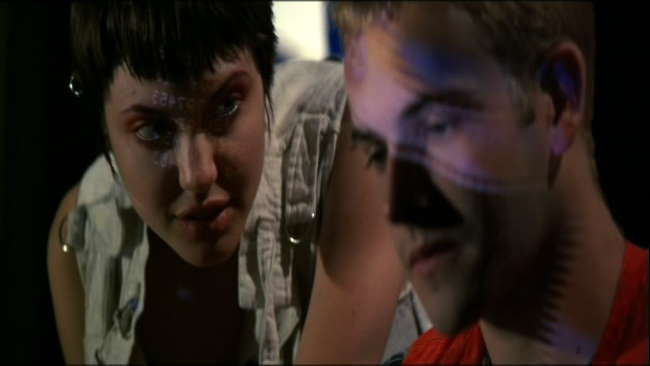
While the larger “destroy the environment for personal and corporate greed” theme is going on, there is also intertwined teenage alienation and bonding themes. Most all the hackers are outcasts from “regular” society. The leads Jonny Lee Miller, who plays hacker “Crash Override,” and Angelina Jolie (Acid Burn) engage in a hacking contest, of which, the loser has to wear a dress on a date (Jolie never wears dresses).
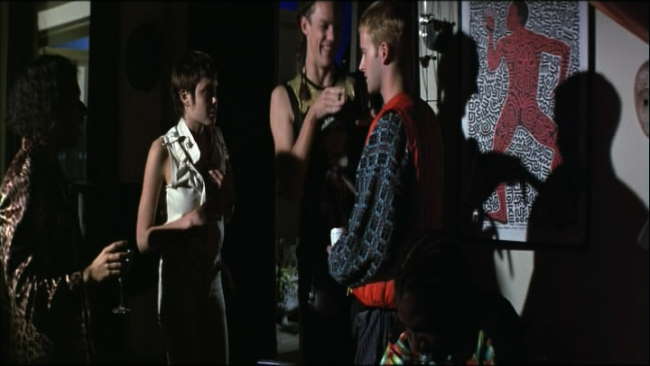
The Hackers: Both Jonny Lee Miller and Angelina Jolie do a great job in playing slick, but semi-nerdish “Elite” hackers. They head up a cast of misfits, all of whom are consumed with breaking in to everywhere just to see if they can. Jesse Bradford, Matthew Lillard, Laurence Mason, and Renoly Santiago all give fun, memorable performances All the popularized hacker approaches are shown here, including social engineering, sifting through trash, and hackers thumbing their nose at authority. The notion of an “Elite,” which is someone in the top 5% of all hackers is given as the ultimate goal for all who aspire to be hackers. To be recognized as such, you have to have a high-profile hack in your history.
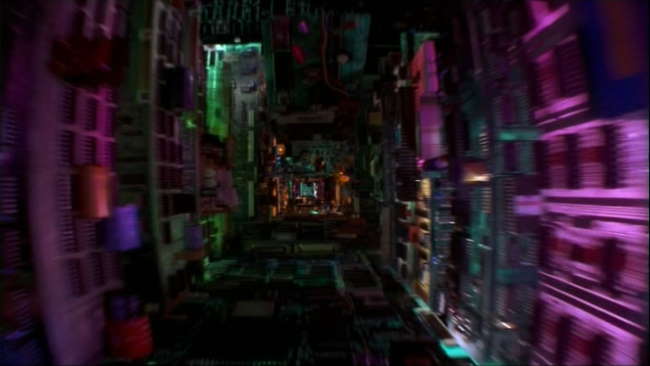
The Visuals: Hackers is more visually interesting due to all the creative hacking cut-scenes interspersed throughout the movie. They serve to glorify hacking, networked computers and the overall hacking lifestyle. Because staring at a computer while typing doesn’t yield exciting celluloid, this was a nice approach to keep things interesting. Unfortunately, it is completely absurd from a realism standpoint (especially the 3D knowledge stores), as hackers pretty much keep to source code and text prompts. Shots of the underground punk scene generally consist of flashes of neon colors in darkly lit, oddly shaped rave bars.
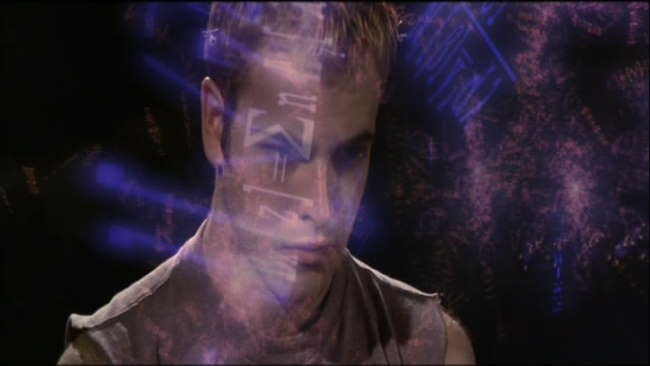
The Bottom Line: There are a bunch of the hacker movie types, but I find Hackers to be on of the most enjoyable to watch. This glorification of the hacker movement is charming, as are most of the hacker co-stars. Miller and Jolie have great chemistry, and make you really care about an otherwise absurd story. Again, don’t look for realism in Hackers, but enjoy it nonetheless.
~See movies similar to this one~
Year: 1999
Directed by: Andy & Larry Wachowski
Written by: Andy & Larry Wachowski
IMDB Reference
Degree of Cyberpunk Visuals: Very High
Correlation to Cyberpunk Themes: Very High
Key Cast Members:
Neo: Keanu Reeves
Trinity: Carrie-Anne Moss
Morpheus: Laurence Fishburne
Agent Smith: Hugo Weaving
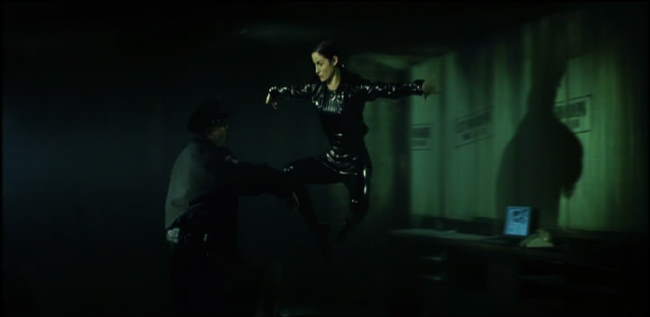
Definitely my favorite opening sequence of all time. Just a great great start to a movie!
Overview: The Matrix is one of my all-time favorite movies, so I’m just not going to attempt to come off as unbiased about it. Additionally, I’m guessing that pretty much everyone who’s coming to this site has seen it - probably numerous times, so I’m guessing a plot description isn’t of much value here. In short, my conundrum with the review is this - what should I say about this movie that will in any way add value to the reader? Answer: Not much. Instead I have decided to keep the bulk of my comments for various essays on the Matrix Trilogy.
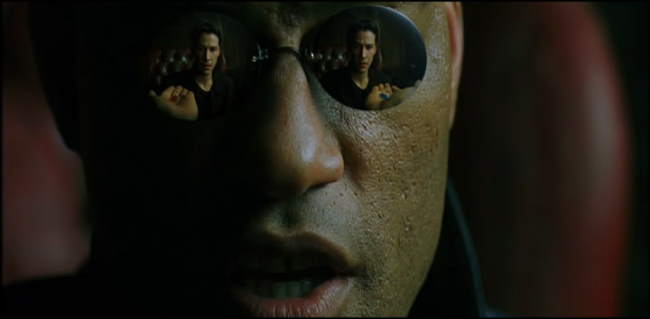
Matrix Influences: The Matrix influenced movies in general and society as a whole. With respect to movies, we see numerous influences, including:
- Special Effects: Bullet time and a myriad of other FX are now standard practice in movies and commercials
- Synonymous with “Cool”: Movies that have a “matrix-like” feel are advertised all the time. We know what this means - it means they aspire to be ultra-sleek, ultra-cool and the “in” thing.
- Fight Sequences: By hiring Hong Kong Martial Arts master Yuen Wo-Ping to coordinate the fights, the Matrix raised the bar on mainstream American movie fight sequences
- Matrix Source Code: The Matrix source code, taken in part from Ghost in the Shell, is everywhere now, and is instantly recognized, as is its meaning
- Hot Chicks in Black Shiny Stuff Kicking Butt: Trinity’s influence has massively upped the anty on action chicks in movies. While Michelle Pfeiffer’s Catwoman in Batman Returns re-initiated this trend, Carrie Anne Moss’ Trinity has made this outfit almost mandatory for female action heroines.
- The use of philosophy in movies: The Matrix seems to have broken the barrier to discussing philosphy in movies. Lets hope this idea lives on.
- Fashion: From Sunglasses, to overcoats to cyberpunkwear, the Matrix has changed the way people dress.
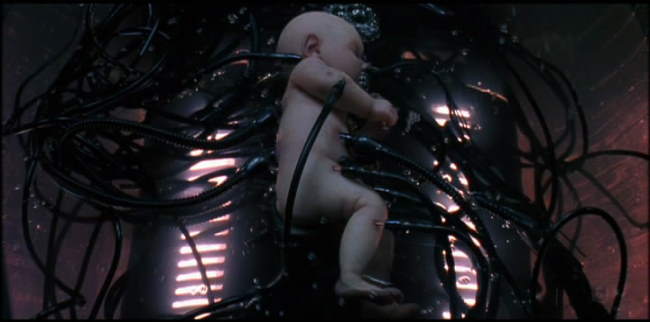
The Bottom Line: The Matrix is already one of the most influential in science fiction, and is truly one of the cornerstone cyberpunk movies in existence. We get it all here: terrific action, awesome cyberpunk concepts, incredible cyberpunk visuals, cool philosophical discussions, an absolutely awesome soundtrack (although DoomAng3l disagrees with this - see his comment below) and innovative FX. On top of this, all the leads were terrific. Reeves makes a perfect Neo, and Moss, Fishburne and Weaving give career-defining performances. Look below for move screencaps on page 2, and additional essays on the Matrix.
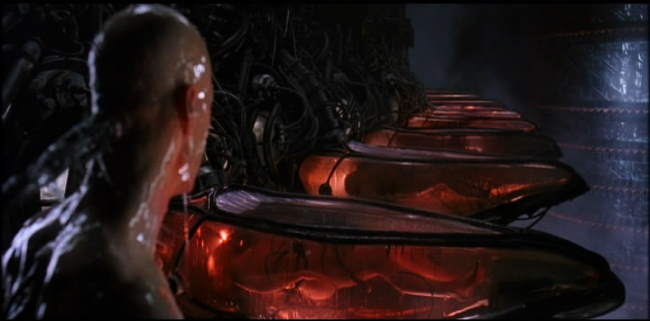
Matrix Essays
- The Matrix Trilogy: A Man-Machine Interface Perspective: This essay explores the Matrix Trilogy specifically from a scifi perspective - the purpose of which is to show how Neo’s journey is really a sequel to Motoko’s transformation at the end of Ghost in the Shell. Developed throughout the trilogy, Neo becomes a fully merged entity comprised of a sentient program with a human.
Page 2: More Screencaps–>>
~See movies similar to this one~
Year: 1983
Directed by: John Badham
Written by: Lawrence Lasker & Walter F. Parkes
IMDB Reference
Degree of Cyberpunk Visuals: Very Low
Correlation to Cyberpunk Themes: Medium
Key Cast Members:
David Lightman: Matthew Broderick
Jennifer Katherine Mack: Ally Sheedy
Dr. John McKittrick: Dabney Coleman
Dr. Stephen Falken: John Wood

Overview: War Games is a wonderful 80s film that captures both the cold war fears and the budding hacker mentality. Mathew Broderick plays a geek teenager named David, who has fun hacking into open modems to noodle around with unidentified computer systems. He finds one computer that likes to play chess. Eventually, he finds this computer also likes to play Global-thermonuclear war. Unfortunately, while playing, he unknowingly starts the Strategic Air Command computer’s countdown to thermo-nuclear war.

This movie is lots funnier when we consider the DoD IT fuckups from the late 70s in building computer-based command and control systems such as this. Twice, in the middle of the night, President Carter got racked out of bed to be told that the Soviets had launched - only a minute later to be told, “Sorry, it was just test data” that was being run on their new $100 Million dollar computer system. After the second such instance, President Carter made it known that he no longer found this amusing. Unfortunately, the designers of this system in their infinite wisdom had the specifications written so that test simulations had to be performed on the live system. For obvious reasons, this is about as bad an idea as has been considered, let alone implemented. They ended up having to spend an additional 50 million to build a test system, that was thereafter known as “Bozo the Clone.”

The Bottom Line: It is definitely a stretch to call War Games cyberpunk. The only thing that makes it so is the pre-Terminator plotline concerning the Military’s attempt to allow machines to manage key decisions for society and the hacker subplot. While not as dystopic as Colossus - the Forbin Project (still awaiting review), the theme is executed competently, especially when combined with what was then the advent of the hacker movement. This is well acted, and for the most part, a decent “pre-cyberpunk” style movie.
~See movies similar to this one~
Tags: cyberpunk movie review Wargames
|



































































